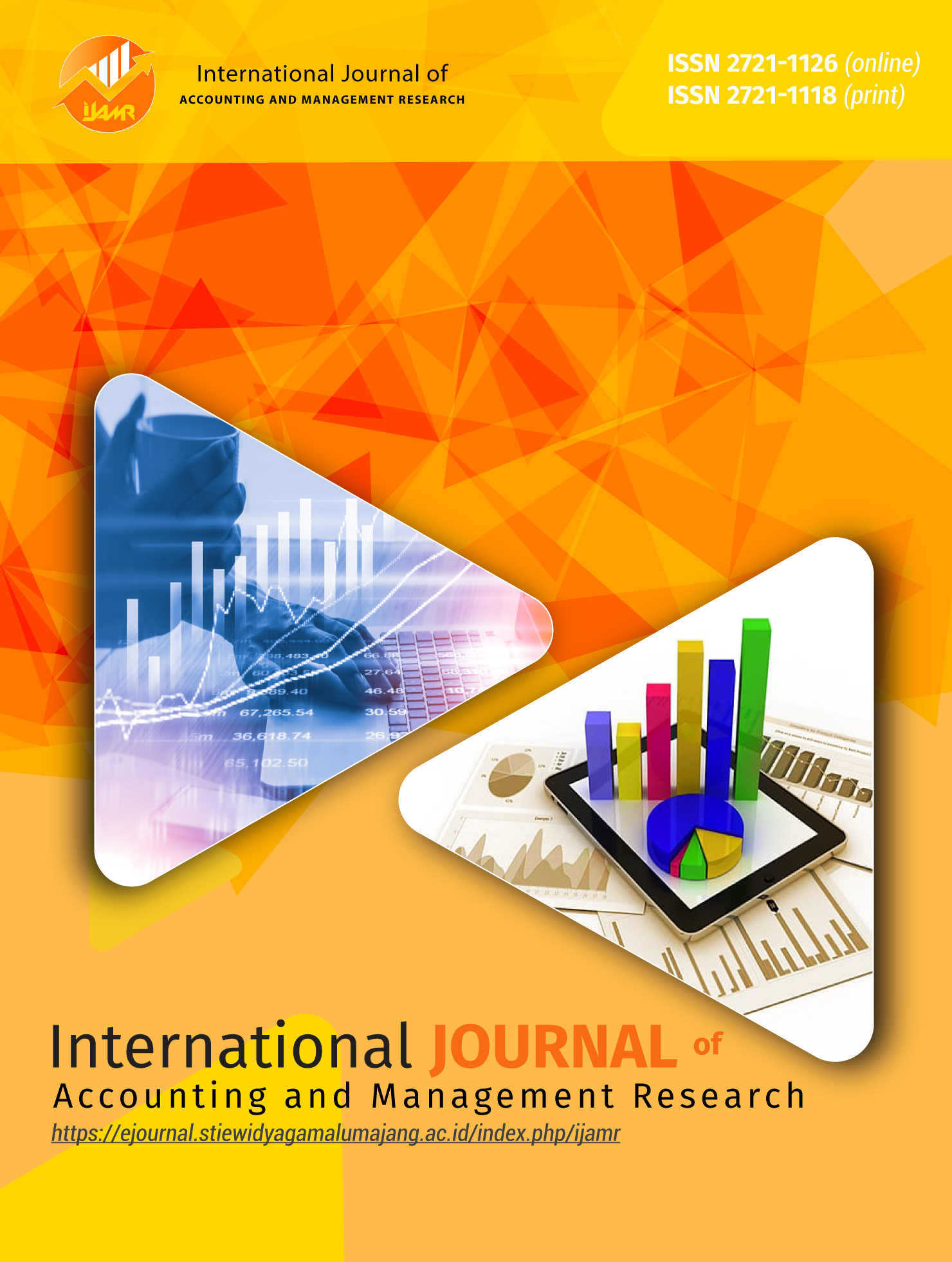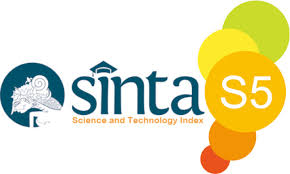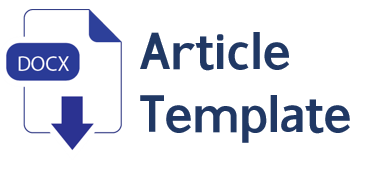How Can the Dimensions of Intellectual Capital Enhance Sustainability Performance? Evidence of Indonesia
DOI:
https://doi.org/10.30741/ijamr.v4i1.1098Keywords:
Capital Employed Efficiency, Human Capital Efficiency, Structural Capital Efficiency, Sustainability PerformanceAbstract
The aim of this research is to examine the extent to which the dimensions of intellectual capital can enhance sustainability performance in Indonesian manufacturing companies. This study utilized data from 174 manufacturing companies listed on the Indonesia Stock Exchange during the period of 2019-2021. The research employed the Multiple Linear Regression analysis method to analyze the data. The dimensions used to assess intellectual capital were Human Capital Efficiency, Structural Capital Efficiency, and Capital Employed Efficiency. Exploratory factor analysis was conducted to determine the impact of intellectual capital dimensions on sustainability performance. The research findings indicate that in the context of sustainability performance, the dimensions of intellectual capital, specifically human capital and capital employed, have a significant and positive impact. In other words, factors related to human resources and effective capital utilization make important contributions to achieving better sustainability performance.
References
Allameh, S. M. (2018). Antecedents and consequences of intellectual capital: The role of social capital, knowledge sharing and innovation. Journal of Intellectual Capital.
Ana, S. R., Sulistiyo, A. B., & Prasetyo, W. (2021). The effect of intellectual capital and good corporate governance on company value mediated by competitive advantage. Journal of Accounting and Investment, 22(2), 276-295.
Bae, K.-H., El Ghoul, S., Gong, Z. J., & Guedhami, O. (2021). Does CSR matter in times of crisis? Evidence from the COVID-19 pandemic. Journal of Corporate Finance, 67, 101876.
Bontis, N. (2001). Assessing knowledge assets: a review of the models used to measure intellectual capital. International Journal of Management Reviews, 3(1), 41-60.
Büyüközkan, G., & Karabulut, Y. (2018). Sustainability performance evaluation: Literature review and future directions. Journal of environmental management, 217, 253-267.
Chahal, H., & Bakshi, P. (2015). Examining intellectual capital and competitive advantage relationship: Role of innovation and organizational learning. International Journal of Bank Marketing, 33(3), 376-399. doi: 10.1108/IJBM-07-2013-0069
Clarkson, P. M., Overell, M. B., & Chapple, L. (2011). Environmental reporting and its relation to corporate environmental performance. Abacus, 47(1), 27-60.
Huda, Isra Ul, and Anthonius Junianto Karsudjono. 2022. “PERKEMBANGAN ASPEK SIKAP SOSIAL DAN ADAT ISTIADAT MASYARAKAT ADAT DAYAK MERATUS DI ERA REVOLUSI INDUSTRI 4.0.” Eqien-Jurnal Ekonomi Dan Bisnis 11 (03): 605–28
Edvinsson, L., & Malone, M. S. (1997). Intellectual capital: HarperBusiness.
Fraguela Formoso, J. Á., Carral Couce, L., Iglesias Rodríguez, G., & CARRICOBA, S. (2013). The path to excellence: A management strategy based on people. Dyna, 80(182), 7-14.
Gross-Gołacka, E., Kusterka-Jefmańska, M., & Jefmański, B. (2020). Can elements of intellectual capital improve business sustainability?—The perspective of managers of SMEs in Poland. Sustainability, 12(4), 1545.
Hayton, J. C. (2005). Competing in the new economy: the effect of intellectual capital on corporate entrepreneurship in high‐technology new ventures. R&D Management, 35(2), 137-155.
Ienciu, N. M., & Matiș, D. (2014). Intellectual capital disclosure of Romanian listed companies Accounting in Central and Eastern Europe (Vol. 13, pp. 143-162): Emerald Group Publishing Limited.
Jardon, C. M., & Martos, M. S. (2012). Intellectual capital as competitive advantage in emerging clusters in Latin America. Journal of Intellectual Capital, 13(4), 462-481.
Lestari, N. I. G., & Adhariani, D. (2022). Can intellectual capital contribute to financial and non‐financial performances during normal and crisis situations? Business Strategy & Development.
Lima, J. P. C., & Antunes, M. T. P. (2011). Reflexões teórico-metodológicas para a proposição de um plano teórico de categorização e classificação do capital intelectual. Paper presented at the Anais do Congresso Associação Nacional dos Programas de Pós-graduação em Ciências Contábeis.
Liu, Y., Zhou, Z., Zhang, X., Xu, X., Chen, H., & Xiong, Z. (2015). Net global warming potential and greenhouse gas intensity from the double rice system with integrated soil–crop system management: A three-year field study. Atmospheric Environment, 116, 92-101.
Mačerinskienė, I., & Survilaitė, S. (2019). Company’s intellectual capital impact on market value of Baltic countries listed enterprises.
Massaro, M., Dumay, J., Garlatti, A., & Dal Mas, F. (2018). Practitioners’ views on intellectual capital and sustainability: From a performance-based to a worth-based perspective. Journal of Intellectual Capital.
Mertins, K., & Orth, R. (2012). Intellectual capital and the triple bottom line: overview, concepts and requirements for an integrated sustainability management system. Paper presented at the 4th European Conference on Intellectual Capital.
Ogutu, H., El Archi, Y., & Dávid, L. D. (2023). Current trends in sustainable organization management: A bibliometric analysis. Oeconomia Copernicana, 14(1), 11-45.
Pedrini, M. (2007). Human capital convergences in intellectual capital and sustainability reports. Journal of Intellectual Capital, 8(2), 346-366.
Pekka-Economou, V., & Hadjidema, S. (2011). Innovative organizational forms that add value to both organizations and community: The case of knowledge management.
Petty, R., & Guthrie, J. (2000). Intellectual capital literature review: measurement, reporting and management. Journal of Intellectual Capital, 1(2), 155-176.
Pulic, A. (1998). Measuring the performance of intellectual potential in knowledge economy. Paper presented at the 2nd McMaster word congress on measuring and managing intellectual capital by the Austrian team for intellectual potential.
Pulic, A. (2004). Intellectual capital–does it create or destroy value? Measuring Business Excellence.
Stewart, G. (1997). Supply‐chain operations reference model (SCOR): the first cross‐industry framework for integrated supply‐chain management. Logistics information management, 10(2), 62-67.
Suki, N. M., Suki, N. M., Sharif, A., Afshan, S., & Rexhepi, G. (2022). Importance of green innovation for business sustainability: Identifying the key role of green intellectual capital and green SCM. Business Strategy and the Environment.
Sveiby, K. E. (1997). The new organizational wealth: Managing & measuring knowledge-based assets: Berrett-Koehler Publishers.
Tarigan, J., Listijabudhi, S., Elsye, S., & Widjaja, D. C. (2019). The impacts of intellectual capital on financial performance: an evidence from Indonesian manufacturing in. Indonesian Journal of Business and Entrepreneurship, 5(1), 65-76.
Tonial, G., Cassol, A., Selig, P. M., & Giugliani, E. (2019). Intellectual capital management and sustainability activities in Brazilian organizations: A case study. Intellectual Capital Management as a Driver of Sustainability: Perspectives for Organizations and Society, 119-138.
Ulum, I. (2013). Model pengukuran kinerja intellectual capital dengan iB-VAIC di perbankan syariah. INFERENSI: Jurnal Penelitian Sosial Keagamaan, 7(1), 185-206.
Vale, J., Miranda, R., Azevedo, G., & Tavares, M. C. (2022). The Impact of Sustainable Intellectual Capital on Sustainable Performance: A Case Study. Sustainability, 14(8), 4382.
Vale, J. A. F. L. O., Vale, V. C. F. T., & Lopes, V. S. C. (2022). Intellectual capital efficiency and financial performance in the hotel sector. International Journal of Learning and Intellectual Capital, 19(1), 53-71. doi: 10.1504/IJLIC.2022.119276
Xu, J., & Wang, B. (2018). Intellectual capital, financial performance and companies’ sustainable growth: Evidence from the Korean manufacturing industry. Sustainability, 10(12), 4651.
Xu, X. L., Li, J., Wu, D., & Zhang, X. (2021). The intellectual capital efficiency and corporate sustainable growth nexus: comparison from agriculture, tourism and renewable energy sector. Environment, Development and Sustainability, 1-19.
Yang, L., Zeng, H., & Xu, P. (2021). A comparative study of service trade competitiveness for green innovation development using the WWYZ model-based on China and the 26 countries along'the Belt and Road'. International Journal of Technology Management, 85(2-4), 165-189.
Yusliza, M. Y., Yong, J. Y., Tanveer, M. I., Ramayah, T., Faezah, J. N., & Muhammad, Z. (2020). A structural model of the impact of green intellectual capital on sustainable performance. Journal of Cleaner Production, 249, 119334.
Yusoff, Y. M., Omar, M. K., Zaman, M. D. K., & Samad, S. (2019). Do all elements of green intellectual capital contribute toward business sustainability? Evidence from the Malaysian context using the Partial Least Squares method. Journal of Cleaner Production, 234, 626-637.
Downloads
Published
How to Cite
Issue
Section
License
Copyright (c) 2023 Selvia Roos Ana, Ratna Wijayanti Daniar Paramita, Retno Cahyaningati

This work is licensed under a Creative Commons Attribution-NonCommercial 4.0 International License.











